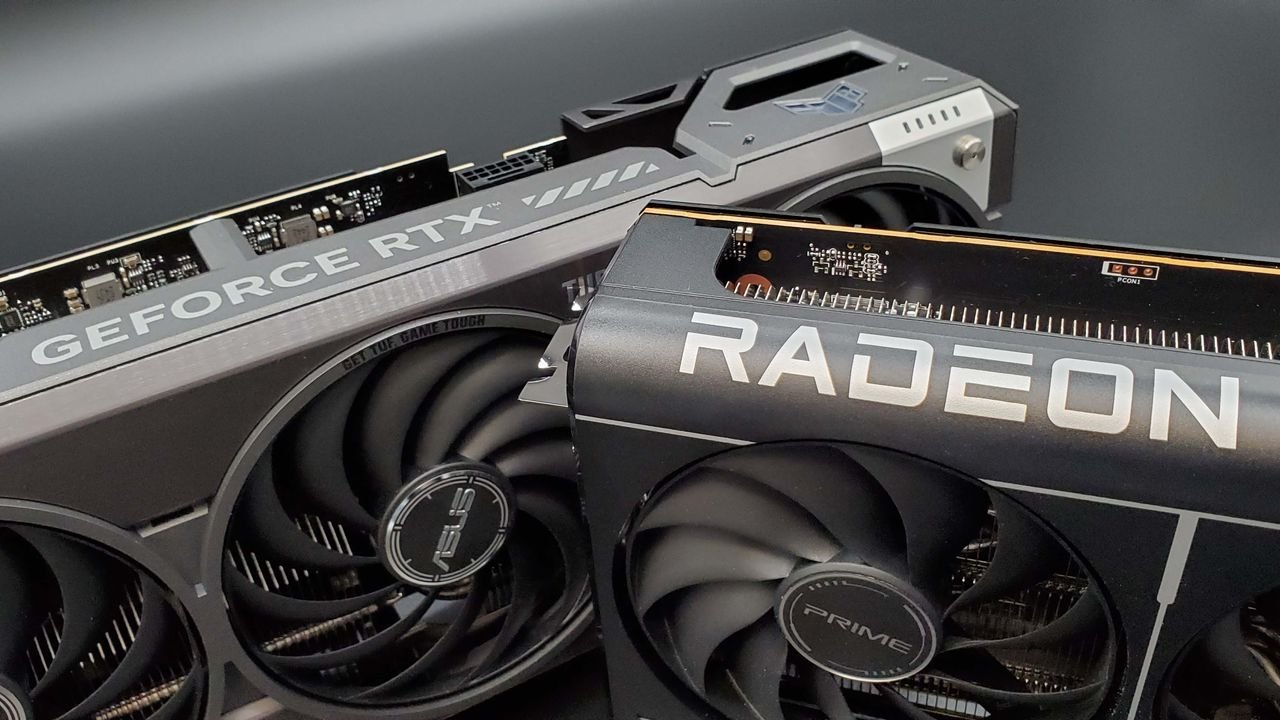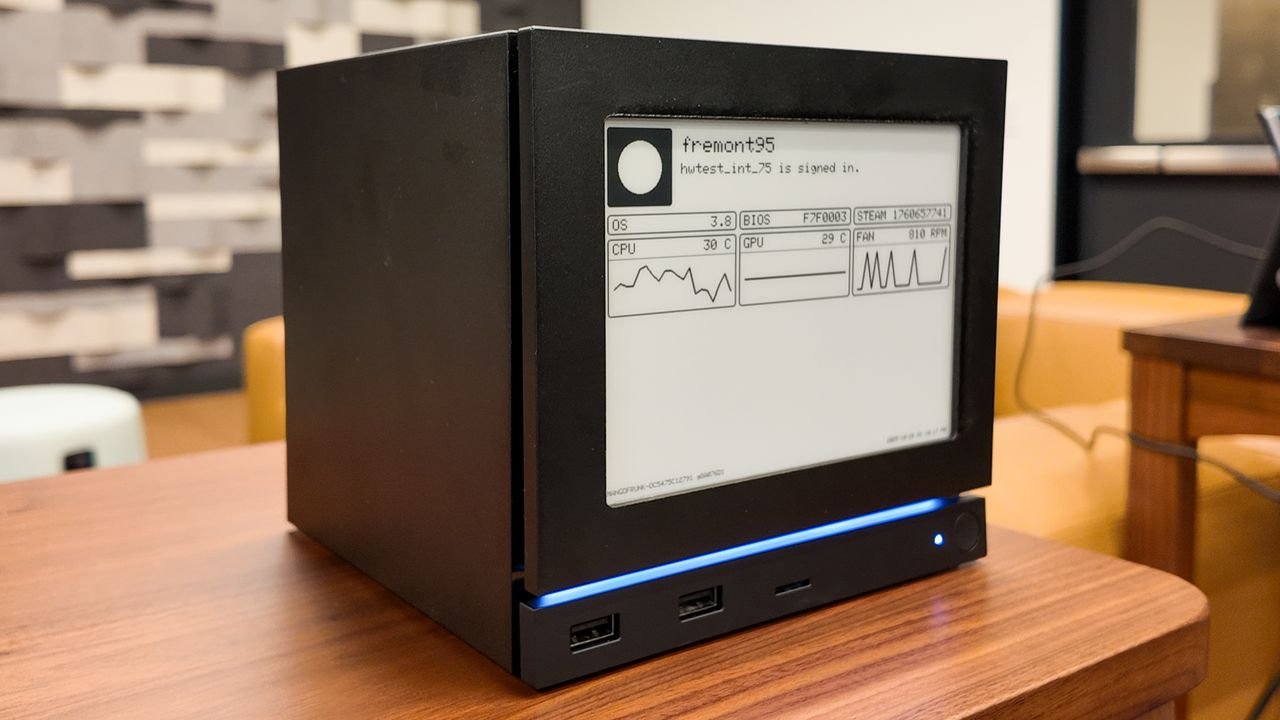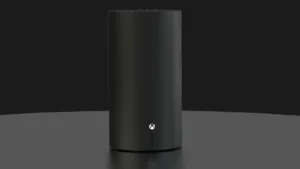AMD vs. Nvidia: Battle of the Graphics Cards
In the battle of the best graphics cards, AMD and Nvidia are the biggest names in the arena, by far. Locking horns in the biggest face-off since Nicolas Cage and John Travolta danced around slo-mo doves inside a church, AMD and Nvidia have been duking it out for supremacy in the GPU market.
Both Team Red and Team Green have their strengths and weaknesses, but which one’s best? There’s only one way to find out. We’ve pitted the storied GPU manufacturers against each other, to see which one has the high ground.
We compare AMD vs. Nvidia with the following in mind:
General Gaming PerformanceRay Tracing PerformanceGaming Laptop PerformanceUpscaling (FSR vs. DLSS)Adaptive Sync (FreeSync vs. G-Sync)Software & DriversPrice ComparisonThe Verdict
AMD vs. Nvidia – General Gaming Performance
Let’s make one thing clear. In terms of 4K performance, Nvidia takes the cake. But, if you plan to invest in a high-end 4K capable GPU, you might want to make sure you have one of the best 4K gaming monitors to take advantage of it.
That’s not to say that AMD’s recent offerings are sub-par by any means. The AMD Radeon RX 7800 XT, for instance, delivers impressive gaming performance, and has a healthy competitive edge when it comes to pricing.
However, if you’re looking for the best gaming PC performance possible and money isn’t an issue, you probably want an Nvidia graphics card like the RTX 4080. While AMD cards are cheaper, cards such as the AMD RX 7800 XT can’t keep up with Nvidia’s top offering.
Although the RX 7000 series features impressive ray tracing, it falls behind Nvidia’s RTX 40 series in terms of ray tracing performance. And its upscaling tech, FSR, or FidelityFX Super Resolution, hasn’t quite caught up with the capabilities of Nvidia’s DLSS, or Deep Learning Super Sampling.
This comes down to the fact that DLSS 3 uses temporal AI upscaling, whereas FSR 3 merely uses temporal upscaling. DLSS 3 provides a superior image quality and performance boost, which FSR 3 cannot match in its current form.
With DLSS 3, Nvidia has implemented AI-powered frame generation, which works in real-time and can effectively double the frame rate. The graphical and performance improvements this technology brings to the table means that Nvidia still leads the charge when it comes to upscaling.
Many consumers tend to choose an AMD graphics card if they have an AMD processor, due to the popular belief that AMD hardware works better together. In reality both AMD and Nvidia GPUs will perform well with either an Intel or AMD CPU.
However, in terms of overall prowess, Nvidia clearly still has the upper hand when it comes to gaming performance.
For raw performance power, the Nvidia GeForce RTX 4090 is unbeatable right now, by a country mile. However, the AMD Radeon RX 7900 XTX makes for a cheaper alternative if you find yourself needing to make a compromise between price and performance.
Winner: Nvidia
AMD vs. Nvidia – Ray tracing performance
Leading the way for ray tracing, Nvidia has always won by lengths in this field. With more power and superior performance, it has traditionally been untroubled by its closest competitor.
However, that said, it may not be the one horse race that you might suppose. AMD has been gaining ground with its ray tracing capabilities, particularly in the mid-range bracket.
AMD’s RX 7000 series has taken the improvements to ray tracing it first achieved with the Radeon RX 6800 XT and cranked things up another notch. Not enough to contend with Nvidia’s dominance, but enough to offer a far less wallet-busting alternative.
AMD’s RDNA 3 architecture, which builds on RDNA 2, which is present in both the RX 6000 series and the PS5, has resulted in noticeable improvements to the overall ray tracing performance of its latest gen GPUs, with brighter and more realistic visuals across the board.
It won’t be enough to trouble Nvidia yet, but AMD is taking steps in the right direction, and has produced a range of GPUs that not only improve significantly on what has come before, but also represents a credible alternative, at least in the mid-range and budget tiers.
Needless to say, you can expect to pay a premium for Nvidia’s top-tier ray tracing performance, not to mention the increase it’s likely to have on your power bill.
However, as is the case with many other categories here, for performance capabilities alone, Nvidia takes it.
Winner: Nvidia
AMD vs. Nvidia: Gaming laptop performance
When it comes to gaming laptop performance, the playing field is uneven between Team Red and Team Green.
Nvidia has historically been the go-to GPU choice for laptop manufacturers, and there therefore have been fewer options for AMD GPUs. And thanks to Nvidia’s DLSS technology, laptop gamers can enjoy an enhancd gameplay performance without having to compromise on image quality.
However, the problem with enhanced performance is that battery life will suffer from the increased demand on power. AMD’s GPUs are, in contrast, a more power efficient option, if you’re prepared to accept the trade-off in performance.
Nevertheless, having managed to maintain its clear lead in the gaming laptop market, Nvidia comes out on top here, with far more options for you to consider.
Winner: Nvidia
AMD vs. Nvidia – Upscaling
Nvidia’s RTX 40 series come kitted out with its latest DLSS 3, which adds frame generation to the mix.
Essentially, this uses artificial intelligence to generate a unique frame of graphics for every second frame, and in real time. This interframe calculation means performance is significantly improved at 4K by adding data to each frame, and effectively doubling the frame rate.
In short, expect far superior image quality, ray tracing, and so on. The downside is that DLSS 3 is limited to the RTX 40 series only, so you’ll only reap its benefits if you’re prepared to fork out for one of Nvidia’s premium GPUs.
In contrast, AMD FSR 3 is an open-source technology, available to all, including Nvidia and Intel. It too carries its own type of interframe calculation, which it calls Fluid Motion Frames.
Unlike DLSS 3, FSR 3 is not a proprietary standard, and runs on a large number of graphics cards. It represents purely temporal upscaling, compared to DLSS 3’s temporal AI upscaling, sharpening up lower resolution images and then enlarging them, instead of rendering the native image at a higher resolution.
Although AMD’s FSR 3 provides better performance than not having any upscaling, it can’t compete at the same level as Nvidia DLSS 3.
DLSS 3 delivers a far superior performance and image quality compared to FSR 3. The kicker is that its performance necessitates greater hardware power, of course, which tends to circle the discussion back to a matter of cost as its bottom line.
Winner: Nvidia
AMD vs. Nvidia – Adaptive sync
Both AMD and Nvidia offer a comparable performance in terms of adaptive sync. AMD’s FreeSync generally provides better value for money, while Nvidia’s G-Sync delivers a marginally better performance overall.
Arguably, opting for Nvidia’s G-Sync could be a significantly more costly investment, too, with only a minimal gain in performance. G-Sync-equipped monitors tend to be more expensive, so you’ll need to consider whether the additional cost of this proprietary hardware is worth it.
Nvidia’s G-Sync tends to be favored by most gamers, due to the overall performance standard that it delivers, which is why many of the best gaming monitors are G-Sync compatible.
The most significant downside to AMD FreeSync is the potential for ghosting (which is when pixel trails appear behind a moving object), despite the reduction in response time. Needless to say, this can be a real drag, and something to consider when making your choice.
When choosing a new GPU it’s important to note which variable refresh rate technology your monitor supports, if any. If your monitor supports FreeSync and not G-Sync or G-Sync Ultimate, you might want to consider an AMD graphics card and vice-versa.
Winner: Tie
Software & Drivers
AMD used to have issues with its drivers, particularly at launch, which have hampered the performance of its graphics cards. However, AMD’s software has improved significantly in the last few years, bolstered by frequent driver updates, resulting in much improved performance overall.
While both AMD and Nvidia update their drivers on a regular basis, due to higher demand for Nvidia’s GPUs, not to mention Nvidia’s deeper pockets, developers tend to favor Nvidia, offering much better support for those with an Nvidia graphics card.
When launching a game, you will often notice this with the optimized for Nvidia or Optimized for AMD logos during the game’s splash screens.
Winner: Nvidia
Price Comparison
Traditionally the domain of AMD, thanks to its more budget-friendly range of graphics cards, the 2023 launch of each company’s respective offerings has done little to change this dynamic.
Pricewise, there’s no comparison here. AMD Radeon graphics cards represent a much cheaper option than any of Nvidia’s. So if you’re looking purely at which is kinder on the wallet, you have your winner.
Choosing an AMD graphics card is certainly the cheaper of the two options. And this remains true across its premium, mid-range, and budget brackets. Whether or not that choice represents the best value for money, however, is open to debate.
Across the top tier, the Nvidia RTX 4090 costs more than $1,500.00, while AMD’s closest rival, the Radeon RX 7900 XTX will only set you back a mere $999.99 or so.
Once you get into the mid-range, however, things begin to look much less polarized. Look at the GeForce RTX 4070 (Nvidia’s most expensive mid-range card, priced around $600.00) compared to the new-kid-on-the-block Radeon RX 7800 XT (approximately $500.00), and suddenly the price divide doesn’t look so vast after all.
At the lower end of the scale, you have offerings from both parties for a shade below the $300 dollar mark. Nvidia’s GeForce RTX 4060 scrapes below this threshold at $299, while the AMD Radeon RX 7600 is positively budget-friendly at a mere $269.
Generally speaking, each team’s latest premium offerings will see you considerably more out of pocket if you opt for the Nvidia route. But set your sights a little lower, and you’ll see more obvious points of comparison, not only in price, but performance as well.
However, the key consideration here should be value for money. Parting with a small fortune in exchange for one of Nvidia’s top tier GPUs could result in a critical hit to your finances. And if you can’t part with the coin, you’ll need to look for a more reasonable alternative.
With this in mind, it’s worth mentioning too, that Intel’s Arc lineup is closing the gap when it comes to low cost GPUs, too, potentially giving AMD a run for its money in the price stakes.
Winner: AMD
AMD vs. Nvidia – The Verdict
Impressive performance across all categories, showcasing superior technologies and a broader range of options, means Nvidia still comes out on top in 2023. However, AMD is beginning to close the gap more noticeably than ever.
AMD’s graphics cards are more competitively priced, making it much a more viable option for many. Plus, a more user-friendly interface helps to make AMD’s GPUs more accessible.
Nvidia’s dedicated RTX technology makes it the best choice for gamers in terms of pure performance, while AMD Radeon offers better value for money, making it more suitable for gamers on a budget.
Ultimately, deciding which one is right for you will come down to personal choice, budget and what games you play, as well as how GPU intensive those games are. For example, if you’re just using your gaming computer to play Minecraft, you might want to reconsider splashing out on an RTX 4090, no matter how nice that card might be.
What is clear however, is that this perpetual war for supremacy has produced some of the best graphics cards yet, which arguably makes us the overall winners here. And with Intel now entering the GPU chat too, things could get very interesting indeed in the near future.











Post Comment